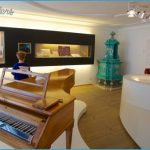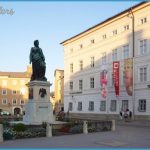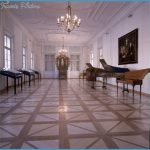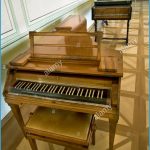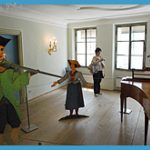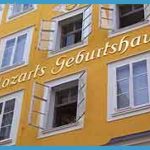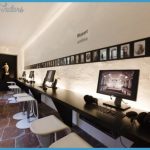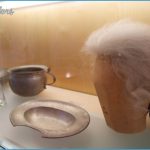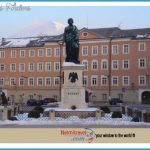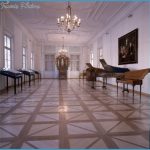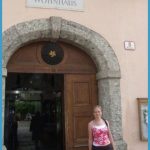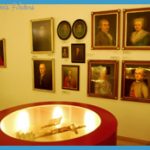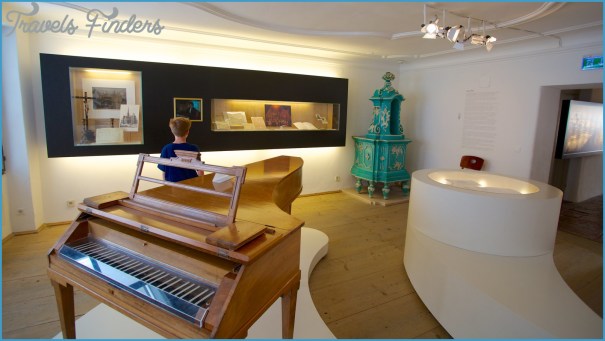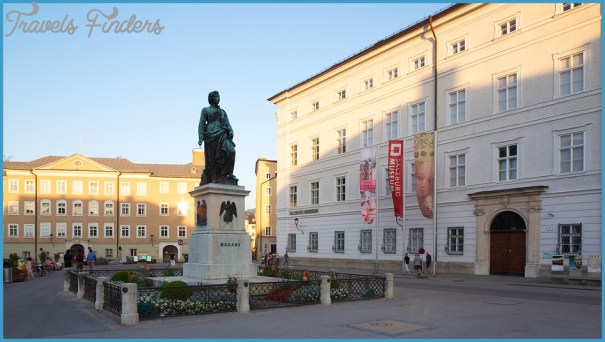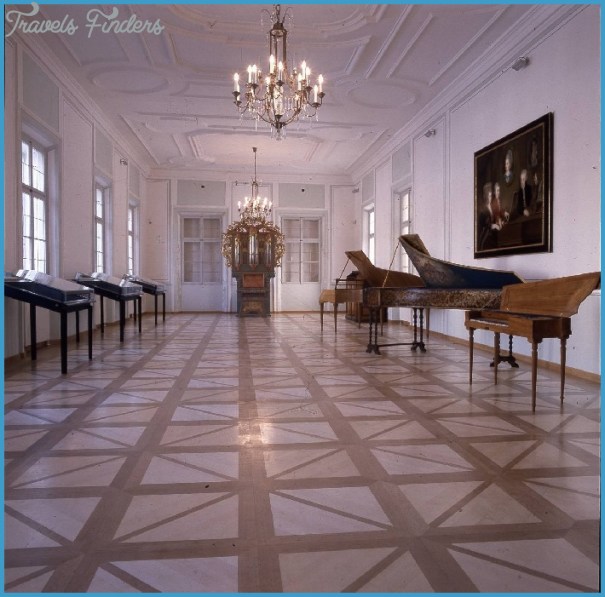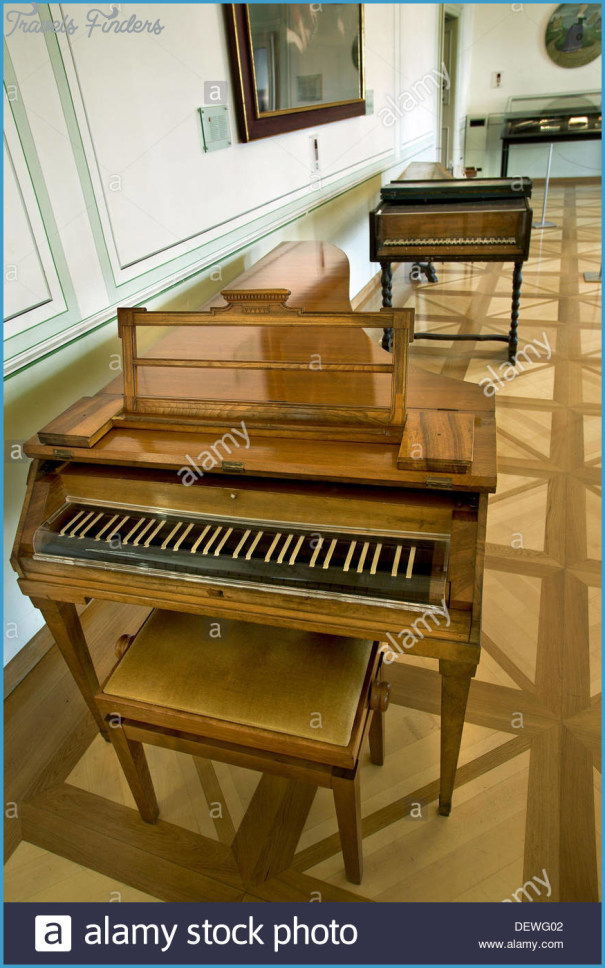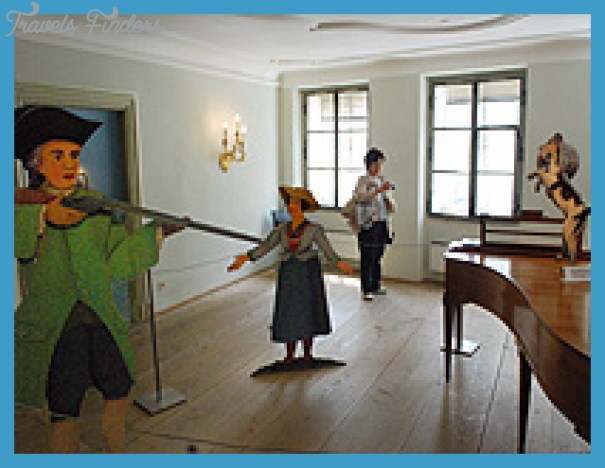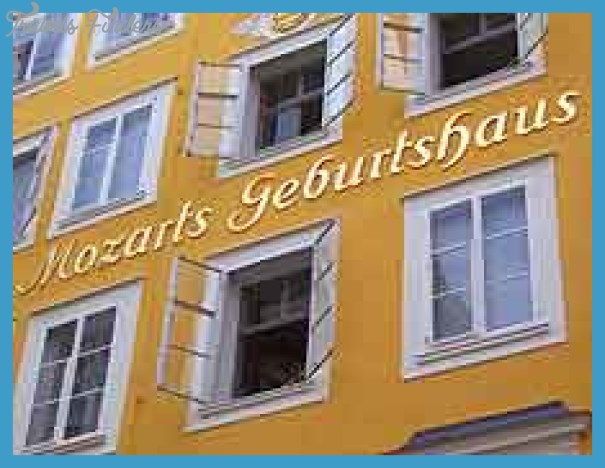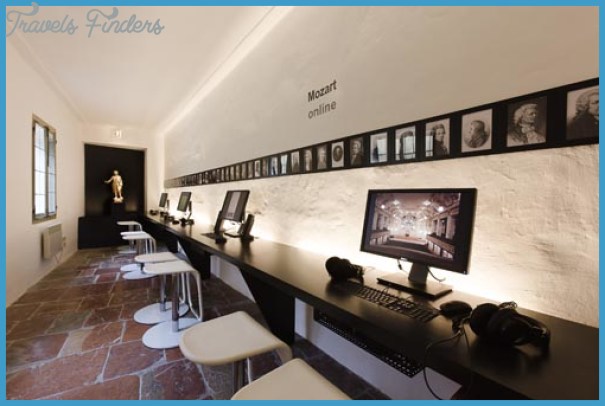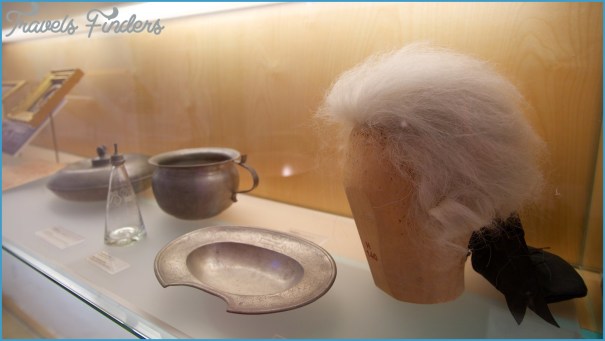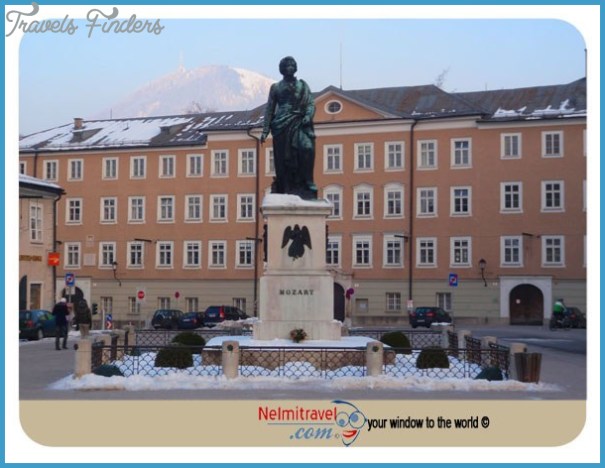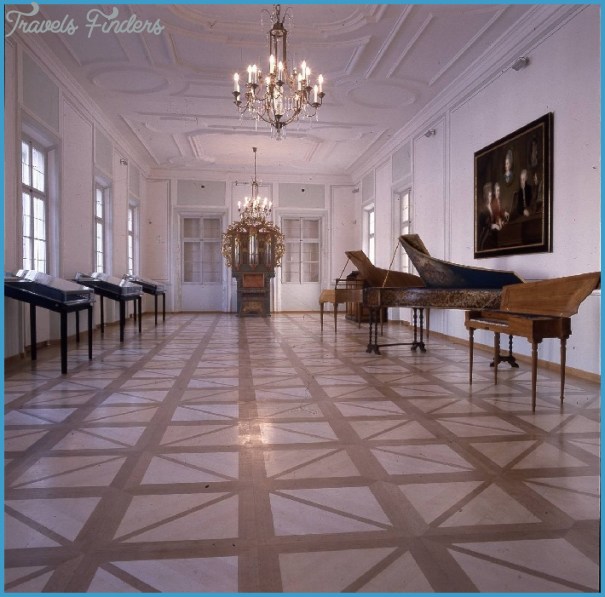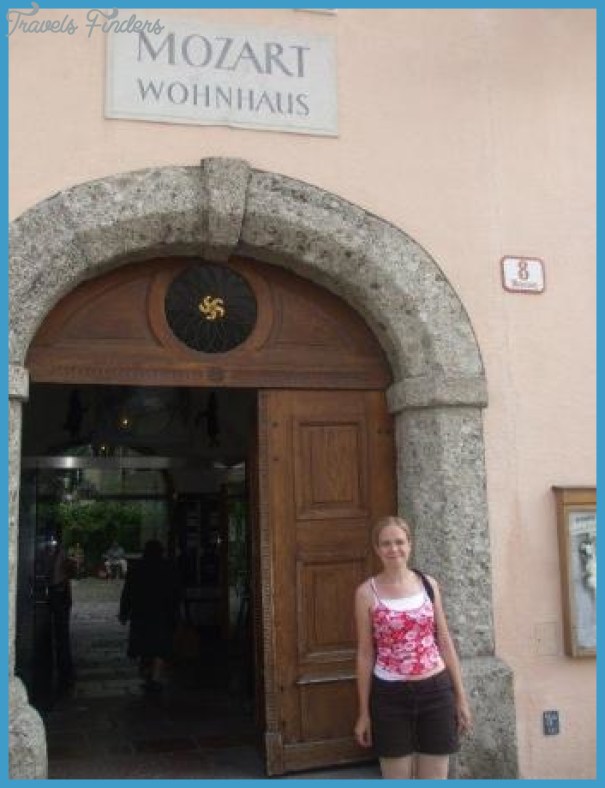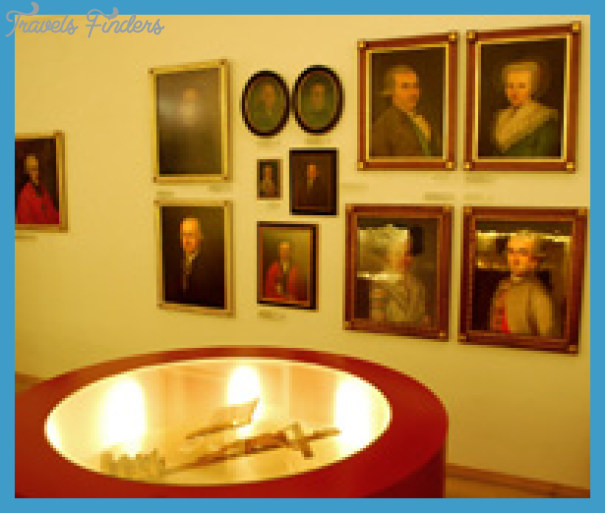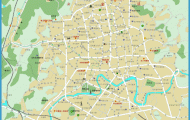MOZART MUSEUM
The commemoration of Mozart, very much a family affair, provides a true reflection of his predominant image over the last two centuries as a prodigiously gifted youngster. There are houses dedicated to the memory of his father and to his mother and his sister. The two major museums to Mozart himself, both in Salzburg, enshrine his boyhood years and his period as a young Konzertmeister in his father’s house. Only those in Vienna and Prague are concerned with his adult life and his greatest music.
The central, the oldest and the most famous of the Mozart museums is of course the one in his Geburtshaus, the house, close to the centre of the old city of Salzburg, in which, in 1756, he was born. It stands in the Getreidegasse, a busy commercial street parallel to the river Salzach, just two rows of buildings above it and not far from the bridge across to what was then the newer part of the city. Behind the Getreidegasse was (and is) a market place, the Kollegienplatz, now the Universitatsplatz, with the University Church across; further back was the huge,
The Mozart Geburtshaus, Salzburg italianate Cathedral, adjoining the Archbishop’s Residenz, close to the Franciscan Church and, behind that, St Peter’s Abbey. It was a convenient situation for Leopold, as a court violinist, who had lived there since his marriage to Maria Anna Pertl in 1747. The house may date back to the 12th century although firm documentation exists only from the 15th. The Getreidegasse house belonged in Mozart’s time to the Hagenauers, a mercantile family, friends and landlords to the Mozarts. A centenary exhibition was held there in 1856, and in 1880 the Internationale Stiftung Mozarteum, formed in 1870, set up a Mozart museum – the first museum in a composer’s former house. The whole building was acquired in 1917, not only the frontage to the Getreidegasse but also the rear portion, overlooking the Universitatsplatz.
In Mozart’s time the front of the house had decorative Rococo window frames, matching those on the Universitatplatz; now they are more austere. Entry is through the arched doorway on the Getreidegasse, then up the stairs to the third floor, where the Mozarts had their quite modest apartment. It consisted then of a small ante-room, opening on to a living-room-cum-music-room, then a bedroom and a small study at the rear; the kitchen was separate, accessible from the landing, where there are portraits of the Hagenauers and showcases with copies of Leopold Mozart’s letters to them. The ante-room display is concerned chiefly with Leopold and his publications, but there is also a copy of a minuet that Mozart wrote when he was five. In the main room are showcases with items to do with the Mozarts’ early travels – letters, diaries, music – and several portraits of Mozart as a child (some of them dubious), as well as his child’s violin and illuminated panels showing each of the four family members on which their lives are outlined. In the bedroom are Mozart’s violin and viola, his travel clavichord, and his Walter piano of about 1780 or a close replica of it (the original is sometimes kept in the Wohnhaus, sometimes here). In the rear room are various personal items, his snuffbox, locks of hair believed to be his, ornamental buttons and other trinkets; also portraits relevant to his later life and beyond – his wife Constanze, their sons, her second husband.
MOZART MUSEUM Photo Gallery
In what was originally a separate flat at the rear, there are informative displays about the Salzburg of Mozart’s day. One room is given over to the church and its dominant role in the city – Mozart’s own ruling prince-archbishops are there, along with prints of the city’s numerous
Mozart’s piano and violin, in the Geburtshaus churches. Another room is devoted to the family’s friends and patrons in Salzburg; the third has an informative display about day-to-day life in 18th-century Salzburg.
Visitors now descend to the second floor, fronting on the Getreidegasse, passing through the museum shop into a series of exhibitions. One is concerned with Mozart’s early stage works – copies of music, correspondence, handbills, costumes, maquettes of his operas showing historical and modern production styles. Then down another level, to the first floor, where the Hagenauers lived: one room, Everyday Life of an Infant Prodigy’, chiefly treats of the travels (prints of England and Italy, travel books, letters, travelling bags, part of a coach), another, Everyday Life at Home’, with a contemporary bed, essays on domestic life in Salzburg (food, hygiene and so on) and the four famous portraits of the family. At the front a room is furnished in 18th-century bourgeois style, perhaps representing a somewhat more elegant way of life than the Mozarts would have enjoyed.
The Getreidegasse apartment grew too small for the Mozarts as the children matured (they cannot go on sleeping like soldiers’, Leopold wrote to his wife). In 1773 the family moved across the river, a distinct leg-up socially speaking, to the Hannibalplatz, now the Makartplatz. Here they took an apartment in the Tanzmeisterhaus, near the Trinity Church (Dreifaltigkeitskirche), just across from the theatre (then as now). The building, which had stood at least since the early 17th century, had once been owned by a Frenchman who taught dancing, including etiquette and courtly manners. One room was still employed for balls and another had been used by Salzburg University. The Mozarts rented an eight-room flat on the first floor, decidedly large for a family of four, with their servants, but it allowed them to accommodate resident pupils and, in the spacious Tanzmeister-Saal, to demonstrate and sell musical instruments. There was a garden at the rear.
This building was labelled Mozarts Wohnhaus’ in 1856, on the centenary of Mozart’s birth; in 1905, in the interests of stricter veracity, an L.’ was added at the front – for Wolfgang himself lived there only from late 1773 to 1777 and 1779 to 1780, whereas Leopold was there until his death in 1787 (see p.26). The first of the few World War II bombs to land on Salzburg demolished much of it, in 1944, and after the war half the site was taken over for an office block. But the Internationale Stiftung Mozarteum acquired it in 1955 and eventually, with Japanese help, demolished the office block and built a replica of the original house, or at least its external facade, in the same peach colour as in the 18th century and with the same type of larch-shingle roof. On 27 January 1996, the 240th anniversary of his birth, it was formally opened as a second Mozart museum.
This is a modern museum, with audio handsets (in six languages), activated by infra-red transmitters, with an informative commentary and with musical illustrations carefully matched to the exhibits – facsimiles and early editions as well as portrayals of the people who impinged upon Mozart’s life and activities. The original Tanzmeister-Saal is a splendid room, looking out over the Makartplatz; its walls are restored to the original pale grey and green. On the long wall is the Tanzmeister-Saal in the Mozart Wohnhaus large and famous portrait of the Mozart family, attributed to J.N. della Croce, showing Mozart and his sister at the piano, Leopold with his violin, and a picture of his mother on the wall behind – it was painted in 1780-81, after her death. Mozart’s Walter piano or its replica is there, with other keyboard instruments more or less of the time, including a harpsichord, an organ and a small domestic fortepiano. A wall display commemorates the Mozarts’ favourite garden game, shooting bolts at targets, and in the showcases are music (printed and manuscript reproductions) and letters germane to the earlier years Mozart spent in the house, including divertimentos, serenades and concertos of the mid-1770s.
What was originally the family living accommodation opens off the Tanzmeister-Saal. The three rooms at the front of the building commemorate in turn Wolfgang, Leopold and Nannerl. In each there is a central display in one or more giant glass pyramids or obelisks, the motif of the museum. The first room is concerned mainly with Mozart’s music for the Salzburg church and court, including Il re pastore, and the works from after his 1777-8 journey to Paris; the letter from Paris telling of his mother’s death is reproduced. The objects shown include his sugar and tea boxes.
In Leopold’s room there are two obelisks, sitting on piles of giant books and containing others from his large and learned library; there are court records and correspondence, as well as pictures to illustrate his life as deputy Kapellmeister at the court. Nannerl’s room has some of her jewellery, letters, extracts from her diaries, and her portrait as the wife, from 1784, of Baron Johann Baptist von Berchtold zu Sonnenburg along with his. It commemorates too their son, Mozart’s nephew, who spent some years in his grandfather’s house.
One room is a re-creation of the family’s living quarters, to show something of the ambience in which the Mozarts lived; it seems surprisingly
Obelisk displays in the Mozart Wohnhaus spacious, and perhaps unnaturally tidy: the neat pile within the obelisk of the new complete Mozart edition may symbolize the vast quantities of music that must have filled much of the Mozarts’ house. No real attempt is made to suggest how the Mozarts actually lived – and we know it was crowded there (Leopold once wrote: We shall have to put up a bed near the door in Nannerl’s room, where the red sofa stands; and the sofa will have to go in front of the stove between your clothes-chest and the bed, so that we can put things on it’). Next is an interactive display of Mozart’s travels Interactive display of Mozart’s travels, in the Wohnhaus – press the switch for any particular journey, and you see his route, with video illustrations of the sites he visited to the sound of recordings of the music he wrote. The final room is devoted to a slide show, elaborately and tastefully done, with a battery of projectors and mirrors, telling the story of Mozart’s life with music and a commentary on the handsets. There is a shop on the ground floor, on the way out.
Ancillary to the main museum is a Ton und Film Museum (originally founded in 1991), on the mezzanine floor, with a collection of historic performances and productions, many of them from Austrian Radio and including Salzburg Festival recordings over some 70 years.
No Mozartian in Salzburg should imagine that with the two museums his or her Mozart pilgrimage is complete. There are reminders of him all over the city. For a start, there is the so-called Magic Flute Cottage’: this wooden summerhouse, originally in the garden of the Theater auf der Wieden in Vienna, is said to have been used by Mozart to compose in peace and quiet when he was working on Die Zauberflote in the summer of 1791, and to rehearse with individual singers. It was given to the Mozarteum, the Salzburg music conservatory in which many of the festival concerts take place, in 1873, and brought to Salzburg. First it was put close to the Mirabell Gardens, then on the Kapuzinerberg; in 1950 it was restored and placed in the Mozarteum garden (for illustration see p.8). The cottage, a single room with windows, is open to the public in the intervals of summer concerts at the Mozarteum (whose main entrances are in Schwartzstrafie, the continuation of the road between the river and the southern side of the Makartplatz).
The large square outside the Archbishop’s Residenz, originally the Michaelerplatz, is now the Mozartplatz, and at its centre is a bronze statue of Mozart, unveiled (in the presence of his sons) in 1842. An important Mozartian site, though not shown to the public as such, is the Residenz itself, where much of his early music was first performed, in the Rittersaal, the Kaisersaal or the Carabinierisaal; no doubt some of his music was given in the Mirabell Palace too. Then there are the churches – above all the Cathedral, where his parents were married, where he was baptized, where he was organist in 1779-80, and for which most of his sacred works were composed, but also the attractively florid St Peter’s, where the unfinished C minor Mass K.427 had its first hearing. One mass was written for the University Church and a school-drama for the university itself. The Mozarts had connections too with the pilgrimage church at Maria Plain, north of Salzburg, for which Wolfgang wrote a mass (K.194), the Franciscan Church, their parish church when they lived in the old city, and St Sebastian’s, their parish church when they crossed the river. It is at St Sebastian’s that Leopold is buried, along with Mozart’s maternal grandmother, Nannerl’s short-lived daughter Jeanette and (ironically) Mozart’s widow Constanze and her second husband, Georg Nikolaus Nissen. Constanze’s sisters Aloysia, Mozart’s first Mozart family graves at St Sebastian, Salzburg love, and Sophie are buried close by. Nannerl is buried in St Peter’s (she died in 1829), as is Michael Haydn. Trinity Church and the Loreto Church were also favoured by the Mozarts; near to them, on the new’ side of the river, lived most of the noble families of Salzburg with whom the Mozarts had links, such as the Lodrons and the Lutzows. Over in the old city, stroll down almost any street and you will see plaques with Mozartian resonances – the houses where Constanze lived with her second husband or her sisters, in the Nonnberggasse and Mozartplatz, or where the aging Nannerl lived, in Sigmund-Haffner-Gasse, where the Haffners had their town houses. (Don’t miss the plaque and statue to Salzburg’s more recent favourite son: Herbert von Karajan’s birth in the rather grand house, now aptly a bank, on the lane from the Makartplatz down to the river and the footbridge, the Mozartsteg, is appropriately recorded.) Mozart first visited Vienna as a child, in 1762, and had prolonged visits in 1767-8 and 1773. He settled there in 1781 on his resignation and dismissal from the Salzburg Archbishop’s service. Like most Viennese at the time, Mozart never stayed long in the same lodging. Of more than a dozen apartments that he occupied during those ten years, the only one where he spent over two years, and the only one to survive in anything like its original form, is the so-called Figarohaus’. Here the Viennese museum to Mozart is situated. He lived in the house, at the junction of SchulerstraSe and Domgasse (the address was Grosse SchulerstraSe in his time), from the late summer of 1784 until the spring of 1787 – his most successful, most prosperous years, which saw the composition of eight of his greatest piano concertos, several string quartets, the Prague Symphony and of course Le nozze di Figaro. His apartment was on the first floor, the piano nobile; there are five storeys in all. The building dates back to at least the 16th century. In the early 18th it was owned by an architect, Andrea Simone Carove, who rebuilt it in more or less its present state; it passed to his son-in-law, Albert Camesina, a well-known stucco artist who worked for the court, and probably did the rich and attractive stucco work still to be seen on the ceilings. His son, who inherited it, died in 1783 and his widow lived on the second floor with her two young sons in Mozart’s time there.
The house, often referred to as the Camesina-House, passed through various hands in the next century, although its status as Mozart’s principal Viennese residence was widely recognized (Brahms is said to have looked up at it with due reverence every time he walked by). It was not until 1906 that a memorial plaque was erected. In 1941, on the 150th anniversary of Mozart’s death, a museum was set up in part of it. Mozart’s flat had been subdivided and only in 1976 was the City of Vienna able to purchase the whole of it, remove the partitions and establish a museum occupying the entire premises; it was opened in 1978. In spite of these vicissitudes, some of the original fabric and decorations remain. The floorboards Camesina room in the Figarohaus’, Vienna are original, the stucco work is still there, some of the gilding can be seen on the carved woodwork and now the wall paint has been carefully investigated by scraping away its 13 layers to establish, as far as anyone can, the colours of Mozart’s time.
The museum is entered from Domgasse (the Schulerstrafie entry is blocked off), through a rather dingy courtyard and up the open stairwell. The apartment is fitted out in the cool, impersonal style favoured in all the Vienna city museums, designed by Elsa Prochazka in the 1990s, with their slightly perverse vertical labelling under spring-loaded, wooden covers. Once past the reception area and shop, where the visitor takes a handset, the first room offers a listening station (there is another later) as well as prints of sites in Vienna associated with Mozart, his publications and his friends, his librettist Stephanie and the composer Salieri among them. In this flat Mozart held the celebrated quartet party in 1785 at which Haydn told Leopold Mozart, visiting Vienna, your son is the greatest composer known to me, in person or by repute’. In the second room the published quartets, dedicated to Haydn, are shown, with a set of music desks for a quartet and a copy of Leopold’s letter to Nannerl reporting Haydn’s words. Also in this room is a map showing the locations of Mozart’s various residences in inner Vienna. The third room is given over to Figaro, its background, its composition and its first performances.
The displays in the next group of rooms are devoted to the various people who played important roles in Mozart’s life during his various times in Vienna -family, friends, employers, patrons. There is a facsimile from the Waisenhausmesse K.139/47a, which he conducted as a 12-year-old at the church in the Rennweg. The House of the Teutonic Order, where he was staying in 1781 just before he resigned from service in Salzburg, is there, with a ticket to a concert at which he played just before. Gottfried van Swieten, an important figure in his career, is represented, as is the
Enlightenment figure and freemason Ignaz von Born. Mozart’s brothers-in-law, the husbands of Aloysia and Josepha Weber, as well as the ladies themselves and Constanze, are there. Josepha was the first Queen of Night in Die Zauberflote, which is represented too with the original Pamina, a handbill, stage designs, and of course Schikaneder. There is a ground-plan of the Rauhensteingasse house, not far away, where Mozart died on 5 December 1791 (the house was demolished in 1964; on the site is a department store, bearing a plaque and with a bust of the composer on the fifth floor). Other exhibits deal with the Requiem and the posthumous literature. The small final room, shrine-like, holds a series of reproductions of Mozart himself.
Haydn was not Mozart’s only distinguished visitor in the Figarohaus. It was probably there that he was visited in April 1787 by a young man from Bonn, called Beethoven, to whom he may have given some tuition. The previous year he had taken in a resident pupil, Johann Nepomuk Hummel, then aged seven; there are tales of his giving the boy lessons in the middle of the night, and of Hummel’s returning years later and describing the room layout as it was in Mozart’s day.
Of the 19 buildings in Vienna where, at one time or another, Mozart lived or lodged, 16 are now demolished. Still standing are those at Tiefer Graben 18, where he stayed in 1773, and the House of the Teutonic Order, at Singerstrafie 7: both bear plaques recording the connection. There are plaques too on or within the buildings occupying several of the other sites: Wipplingerstrafie 19 (where he stayed in 1768); Milchgasse 1, the house Zum Auge Gottes’ (summer 1781); Judenplatz 3-4 (1783-4); Landstrafier Hauptstrafie 75-7 (1787-8); and
Wahringer Strafie 26 (1788-9). Some of the places where he played are also marked by plaques: the Palais Collalto (Am Hof 13), where he made his debut in Vienna, as a boy of six; by the Waisenhauskirche (‘Orphanage church’, Rennweg 91), where he conducted his Mass in 1768; at Himmelpfortgasse 6, where he directed performances in 1788; and at Obere Augartenstrafie 1, commemorating the concerts he gave in the Augarten. There is also a memorial in the Kruzifixkapelle in St Stephen’s Cathedral, at the entrance to the crypt, marking where his body rested on 6 December 1791. There is a memorial in the St Marx churchyard, in Leberstrafie in the third district of Vienna, to the south-east of the city, at a point supposedly close to the unmarked grave in which Mozart was buried; a further memorial, by Hans Gasser, originally erected at St Marx in 1859, was transferred in 1891 to the Zentralfriedhof in the Simmeringer Hauptstrafie. There is a statue in Vienna in the Burggarten, the garden of the former imperial palace, made by Victor Tolgner in 1896 and moved there in 1953.
Mozart memorials in Vienna do not end there. His Zauberflote collaborator, Emanuel Schikaneder, lived for a time in Nufidorf, on the northern side of the city. His house was much later owned by Franz Lehar, and maintained in his memory after his death (see Schikaneder). Among the exhibits are two large, elderly wooden armchairs, said to have been stage props made for the premiere of the opera. The Mozart room in the Kunsthistorisches Museum, Room XIII, houses instruments in the collection (the Sammlung alter Musikinstrumente) of Mozart’s time or with some special link to his music – for example, there is a Metallspiel’ of the kind probably used in Die Zauberflote, a glass harmonica, basset-horns, and fortepianos by two of his favourite makers, Stein and Walter. There are numerous places in Vienna with Mozartian connections – halls, palaces and private houses in which he played or taught, and churches in which he worshipped or for which he composed. It is worth mentioning just the Michaelerkirche, in the Michaelsplatz, close by the Hofburg (and the site of the former Burgtheater, where Die Entfuhrung aus dem Serail, Le nozze di Figaro and Cost fan tutte were first performed and Mozart gave many concerts): in this church, music from his unfinished Requiem was played in his memory five days after his death.
Prague has always won brownie points in the Mozart literature: Mozart may have hated Salzburg, and have come to be ignored by the fickle Viennese, but he was always loved in Prague. The truth is a little less simple. But he is commemorated there. Mozart visited the city five times, first in early 1787, when he directed the eponymous symphony and won praise for Figaro; then later that year, for the premiere of Don Giovanni; then twice in 1789, travelling between Vienna and northern Germany; and finally in the late summer of 1791, for the premiere of La clemenza di Tito. The opera house in which his two works were first given still stands. Built by Count Nostitz-Rieneck in 1783, it was first called after him, Nostitz Theatre, then (in Mozart’s time) it became the Estates Theatre, then the Tyl Theatre (after the playwright who wrote the words of the Czech national anthem): now it is back to Estates Theatre (in Czech, Stavovske Divadlo). Mozart operas are often given there and it was also used for scenes in the film Amadeus.
But there is also a dedicated Mozart museum in Prague. Mozart had a good friend in the city, a singer from a Salzburg family, Josepha Hambacher, who had married the composer Frantissek Xaver Dussek. He often stayed with them in the city. The Dusseks had a summer home, in the Smfchov district – then an idyllic country area, close by a monastery, now an industrial quarter of the city within which their house is a small haven. Here Mozart probably completed Don Giovanni.
The original house was built by a brewer in the 17th century; in 1784 it was bought from the Bertram family by Josepha Dussek, who sold it after her husband’s death in 1799. In the ensuing years the Bertramka House (as it was known) was probably modified a good deal but in 1838 its owner Lambert Popelka formed a Mozart Society to conserve it. In the 1870s it was partly destroyed by fire but one corner – the
Recital hall at the Bertramka house, Prague one, it is understandably claimed, with the two rooms that Mozart most probably used – was largely spared. In the absence of plans or dependable pictures of the original the rest of the house was rebuilt conjecturally. A descendant of the Popelka family bequeathed it in 1925 to the Internationale Stiftung Mozarteum of Salzburg, but there were financial difficulties over its maintenance and a Czechoslovak Mozart Society, formed in 1927, eventually took it over. The two Mozart rooms were set up as a museum in the 1930s and the rest became the living quarters of the head of the Mozart Society. After World War II the cost of maintenance again outstripped resources and in 1956, Mozart’s bicentenary year, the state underwrote its reconstruction in a style as close as possible to the original and opened it to the public as a museum. Further restoration was needed in 1986 and it was reopened on the bicentenary of the premiere of Don Giovanni in October 1987. The garden was converted into a miniature auditorium; recitals are given in the attached music room several evenings of the week (and mornings in the summer months) during most of the year; it seats about 70, but 300 more can listen in the garden when, on summer evenings, the french doors are opened. The museum offers a particularly pleasant ambience in a series of rooms decorated in 18th-century style; there are painted beams and wall decorations of flowers and fruit, and chandeliers of glass or porcelain. Music by Mozart wafts gently through. In the entrance hall there are exhibits dealing with the history of the Bertramka House. This leads into the largest room, where there is a fortepiano that Mozart is said to have played during his first visit to Prague; that visit, and the return later in 1787 for the Don Giovanni premiere, are the subject of the display, which includes other period instruments. The next two rooms, supposedly Mozart’s original study and bedroom, have a harpsichord that he may have played at Count Nostitz’s Prague palace, in an elegantly furnished setting, and in the bedroom some of the original ceiling paintings. Of the three further display rooms, one is focussed particularly on Mozart’s last visits to Prague, in 1789 and in 1791 for La clemenza di Tito, one on Mozart traditions and their influence in the Czech Republic (this includes a model of the Estates Theatre at the time of Don Giovanni) and the last on the Dusek family. Mozart played in numerous Prague houses during his visits but there are no commemorative plaques except on the inn Zu den drei goldenen Lowen’ (The Three Golden Lions, Uhelny trh 1/420), the property of the Duseks, where he lodged at the beginning of his first visit and again at the time of the composition of Don Giovanni; tradition has it that Da Ponte stayed at the inn opposite, and that consultations between composer and librettist were conducted from upper windows across the yard below. The Mozart family’s earliest origins have been traced to the Swabian villages to the west and north of Augsburg. A Heinrich Motzart lived in Fischach in 1331 and the name appeared in other villages soon after, notably in Heimberg, where a plaque on a house notes the presence there in 1486 of an Andris Motzhart, a direct ancestor of the composer. By that date several members of the family had begun to settle in Augsburg where they were well established by the mid-17th century. A plaque records the presence of Wolfgang’s great-great-uncle Hans Georg Mozart (1647-1719) on a house, AuSeres PfaffengaSchen 24; Leopold’s father, Johann Georg Mozart, lived in the same street in 1712-16. The family also had connections with the Heilig Kreuz monastery.
But the main Mozartian shrine in Augsburg is the Mozarthaus at Frauentorstrafie 30. Here Leopold’s father lived from 1709 to 1712 and from 1716. His first wife died, childless, in 1718; Leopold, born in November 1719, was the first child of his second marriage. The family moved, probably in 1721, to Jesuitengasse 25 (Franz Alois Mozart, Leopold’s brother, later lived at Jesuitengasse 26, where Wolfgang enjoyed the lively company of his cousin Maria Anna Thekla on his visit in 1777). One room became a Gedenkraum’ (‘memorial room’) to Leopold in 1937; two years later the whole house was presented to the municipality by its owners, a local brewery. After the war it was opened as a museum, then was redesigned on Mozart’s 225th anniversary in 1981 and again on Leopold’s bicentenary in 1987.
The upper part of the Frauentorstrafie house is a carefully organized museum, primarily to Leopold, secondarily to his Leopold Mozart’s birthplace, Augsburg son. There is first a small concert room, with a fortepiano by the local maker J.A. Stein (whose instruments Mozart specially admired). One display room deals with the family’s roots in the Augsburg region and their activities in the city. Another two are concerned with Leopold’s youth in Augsburg and his musical life there, and a fourth with his move to Salzburg in 1737. There are informative and neatly labelled displays of letters and other documents, all of them transcribed. On the second floor the displays in the first room deal with Leopold’s own work as a composer and his character as a man (the influences on him, his own influence on violin playing, with copies in many languages of his Violinschule); in three further rooms his travels with the young Wolfgang are outlined – in western and northern Europe, in Munich and Vienna, in Italy. There are numerous prints, with maps as additional visual help, along with display boards. Mozart’s maternal ancestry has never been as much celebrated as his paternal.
His mother, Maria Anna Walburga Pertl, was born on Christmas Day 1720 in St Gilgen, a fishing village on the Wolfgangsee where lace-making was the local craft, some 15 km east of Salzburg. Her father, a lawyer, was civil commissioner (‘Pfleger’) for the district and lived in rooms at the local courthouse, lately rebuilt. He died in 1724 and Maria Anna and her mother moved out. The house later resumed its link with the Mozart family: when in 1784 Mozart’s sister Nannerl married Baron Berchtold zu Sonnenburg, he was the civil commissioner at St Gilgen, so Nannerl lived in the house of her mother’s birth from then until her husband’s death in 1801, when she moved back into Salzburg. The house, close by the lakeside, and commanding a typicallyAustrian panoramic view, still holds the district court.
But there is a plaque (erected in 1906) to commemorate the Mozart connection, and two small rooms on the ground floor are given over to a display about the Mozarts and St Gilgen, duly emphasizing the female side – with portraits, reproductions, music in Nannerl’s hand, facsimiles of birth certificates and other documents, and a family tree. St Gilgen also has a Heimatkund-lichesmuseum, showing (among other items) lace bobbins of the kind Mozart’s grandmother and mother will have used and glassware from a glassworks set up in 1701; relatives of Nannerl’s lived in the building in her time. The local church, St Egidius, played a major role in the lives of the Mozart relatives: there his maternal grandparents were married, his mother was baptized, his grandfather buried, his sister married and her husband buried. Nannerl played the organ there, and her father-in-law had baroquized’ the formerly Gothic building. Mozart’s extensive travels, from his sixth year to his penultimate one, mean that there are numerous Mozart slept here’ – or played here’ – sites dotted across Europe.
Several are commemorated with plaques. Among them are four in Italy: in Rovereto, at the Palazzo Todeschi (Via Mercerie 14), the site of his first concert in Italy, in 1769; in Verona, in the lobby of the rebuilt Albergo due Torri (Piazza San Antonio 2), where he and his father stayed in 1769-70; at Lodi, noting (at Corso Mazzini 88) the site – incorrectly, and giving the wrong date – of the inn where in 1770 Mozart composed his first string quartet; and in Venice, at the Casa Ceseletti by the bridge of Rio di Barcaroli, where the two spent a month in 1771. There is a memorial in Germany at Wasserburg-am-Inn, between Salzburg and Munich, at the Gassner-Brau (formerly the inn Zum goldenen Stern, Farbergasse 3), and in a Frankfurt museum a piece of glass from a window at their lodgings, allegedly scratched by Leopold to mark their visit, is preserved. In France a plaque at the Hotel de Ville in Dijon marks Mozart’s brief visit in 1766, and there is a memorial to Mozart’s mother in the St Cecilia chapel of the church of St Eustache in Paris (as well as one to Rameau), although her actual grave there has disappeared. In Olomouc, in Moravia, a plaque with a relief portrait notes the Mozarts’ stay at the deanery during the Viennese smallpox epidemic of 1767. There is a plaque at Renngasse 4, on the site of the house in Baden, south of Vienna, where Mozart stayed with his wife in his last summer, and another at the Baden parish church, St Stephen’s, noting his dedication of his Ave verum corpus to the then director of its choir, Anton Stoll. Finally, two places in London where the Mozarts stayed in 1764-5 are marked with plaques: the house in Ebury Street, Victoria (implausibly claimed as the site of the composition of his first symphony), and the building (the back of the Prince Edward Theatre) on the site of the house they occupied in Thrift (now Frith) Street, Soho. It may also be mentioned that a plaque on a house in Copenhagen commemorates the years, 1812-20, that Constanze spent there with her second husband.

